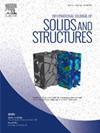Coupled thermal-electrical–mechanical characteristics of lightning damage in woven composite honeycomb sandwich structures
IF 3.4
3区 工程技术
Q1 MECHANICS
International Journal of Solids and Structures
Pub Date : 2024-10-05
DOI:10.1016/j.ijsolstr.2024.113090
引用次数: 0
Abstract
In this study, lightning strike damage of woven carbon fibre-reinforced polymer laminates (W-CFRPs) and woven composite honeycomb sandwich panels (W-CHSPs) are simulated using the proposed sequential thermal-electrical–mechanical finite element (FE) coupling model incorporating dielectric breakdown of materials. Surface current with an amplitude of 200 kA and corresponding lightning shockwave overpressure were applied on each composite. The FE model coupled with LaRC05 criterion was used to study the failure behaviours of intralaminar damage and interlaminar delamination of the W-CFRPs and W-CHSPs. A series of lightning strike tests were performed to validate the FE model. Detailed lightning damage assessments and mechanisms were characterized by a combination of visual inspection, image processing, ultrasonic scanning and micro computed tomography (Micro-CT) and showed good agreements with the FE-predicted results. It can be concluded that shockwave overpressure significantly impacts lightning-induced damages, thereby supporting the effectiveness of the newly proposed sequential thermal-electrical–mechanical coupling model, which demonstrates improved predictive accuracy.
编织复合蜂窝夹层结构中雷电损伤的热-电-机械耦合特性
本研究采用所提出的包含材料介电击穿的热-电-机有限元(FE)耦合序列模型,模拟了编织碳纤维增强聚合物层压板(W-CFRP)和编织复合蜂窝夹芯板(W-CHSP)的雷击损伤。在每种复合材料上施加了幅值为 200 kA 的表面电流和相应的雷电冲击波超压。该 FE 模型与 LaRC05 准则相结合,用于研究 W-CFRP 和 W-CHSP 的层内损伤和层间分层的破坏行为。为验证 FE 模型,进行了一系列雷击试验。通过结合目视检查、图像处理、超声波扫描和微型计算机断层扫描(Micro-CT),对详细的雷击损伤评估和机制进行了表征,结果显示与有限元模型的预测结果一致。可以得出结论,冲击波超压对雷电诱发的损坏有显著影响,从而支持了新提出的热-电-机耦合顺序模型的有效性,该模型显示出更高的预测精度。
本文章由计算机程序翻译,如有差异,请以英文原文为准。
求助全文
约1分钟内获得全文
求助全文
来源期刊
CiteScore
6.70
自引率
8.30%
发文量
405
审稿时长
70 days
期刊介绍:
The International Journal of Solids and Structures has as its objective the publication and dissemination of original research in Mechanics of Solids and Structures as a field of Applied Science and Engineering. It fosters thus the exchange of ideas among workers in different parts of the world and also among workers who emphasize different aspects of the foundations and applications of the field.
Standing as it does at the cross-roads of Materials Science, Life Sciences, Mathematics, Physics and Engineering Design, the Mechanics of Solids and Structures is experiencing considerable growth as a result of recent technological advances. The Journal, by providing an international medium of communication, is encouraging this growth and is encompassing all aspects of the field from the more classical problems of structural analysis to mechanics of solids continually interacting with other media and including fracture, flow, wave propagation, heat transfer, thermal effects in solids, optimum design methods, model analysis, structural topology and numerical techniques. Interest extends to both inorganic and organic solids and structures.

 求助内容:
求助内容: 应助结果提醒方式:
应助结果提醒方式:


